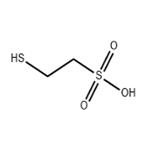Mistabronco,UCB,W. Germany,1973
2,100 g of β-S-thiuronium ethanesulfonate were placed in a solution of 2,100 cc of concentrated aqueous ammonia and 400 cc of water. The mixture was carefully warmed on a steam bath and an exothermic reaction ensured, at which point the β-S-thiuronium ethanesulfonate passed into solution. After standing for two hours at room temperature, the solution was concentrated until all of the excess ammonia had been removed.
The resultant clear solution from the ammonolysis reaction was processed through "Amberlite IR-120" ion exchange resin and converted into β-Smercaptoethanesulfonic acid in 93.7% yield (based on β-S-thiuronium ethanesulfonate).
It is expedient not to heat the reaction mixture rapidly since this increases the loss of ammonia and effects an incomplete reaction. Heating the mixture too rapidly may retard the ammonolysis reaction entirely. The amount of ammonia used is considered to be a satisfactory minimum and larger quantities of ammonia are not found to have any beneficial effect on the reaction. It is also expedient to remove the excess ammonia before processing the guanidinium β-mercaptoethanesulfonate solution through the ion exchange resin since the resin will also remove the ammonia with the result that the capacity of the resin for the exchange of guanidinium ions will be reduced.
Although the preparation of β-mercaptoethanesulfonic acid through the ammonolysis reaction is the preferred method, it is also possible to prepare the sulfonic acid by the sodium hydroxide hydrolysis of β-S-thiuronium ethanesulfonate followed by the ion exchange treatment. The resulting acid,
however, is generally not as satisfactory as that prepared by the ammonolysis
reaction.

